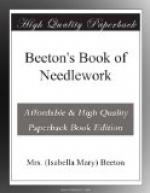No. 460 is a rosette or star which is used to fill circles of braid, and forms the centre of many modern point lace patterns. It is worked upon a pattern traced and pricked in small holes at equal distances. Two threads are employed, one coarse tracing thread, the other of finer thread. The coarse thread is laid on thus:—Pass the needle containing the fine thread, No. 12, through one of the pricked holes, over the tracing thread and back through the same hole; repeat, following the traced outline until the whole of the coarse thread is laid over the outline, then work over in tight button-hole stitch with picots or purls, as on the Raleigh bars (see page 477). This mode of laying on tracing or outlining thread is also applied to fine braid and to point lace cord, as in the alphabet No. 400 (see page 500).
[Illustration: 460.—Rosette for centre of Point Lace Circles.]
BARS.
The word Bar is applied to the various stitches used to connect the various parts of point lace work, and the beauty of the work depends greatly upon the class of bar and its suitability to the lace stitches used. The simplest bar is—
No. 461.—THE SORRENTO BAR.—It is worked from right to left, a straight thread being carried across and fastened with a stitch. The return row consists of a simple twist under and over the straight thread; three of these bars are usually placed close together at equal distances between each group. The thread is sewn over the braid in passing from one spot to another.
[Illustration: 461.—Sorrento Bars.]
[Illustration: 462.—Sorrento Bars.]
Sorrento bars are also applied as shown in illustration No. 462.
No. 463.—D ALENCON BARS are worked upon point de Bruxelles edging, and are only applied to the inner part of a pattern, never being used as groundwork bars. The thread is merely passed three times over and under the point de Bruxelles stitches, the length of these bars being regulated by the space to be filled; when the third bar is completed a tight point de Bruxelles stitch is used to fasten off the bar, the thread is passed through the next point de Bruxelles stitch, and a second bar begun.
[Illustration: 463.—D’Alencon Bars.]
[Illustration: 464.—Venetian Bar.]
No. 464.—THE VENETIAN BAR is so simple that it hardly needs description. It is worked over two straight threads in reverse button-hole stitch. No. 465 shows the Venetian bar applied as the “veining” of leaf, and worked upon Sorrento bars.
[Illustration: 465.—Venetian Bar.]
No. 466.—VENETIAN BARS are worked so as to form squares, triangles, &c., in button-hole stitch upon a straight thread. The arrow in the illustration points to the direction for working the next.
[Illustration: 466.—– Plain Venetian Bars.]
No. 467.—BARS OF POINT D’ANGLETERRE.—These bars may be worked singly or to fill up a space, as in illustration. Work rosettes as in point d’Angleterre, page 461; when each rosette is finished twist the thread up the foundation thread to the top, fasten with one stitch, then pass it under the parallel line running through the centre and over into the opposite braid; repeat on each side of each rosette, inserting the threads as in illustration.




